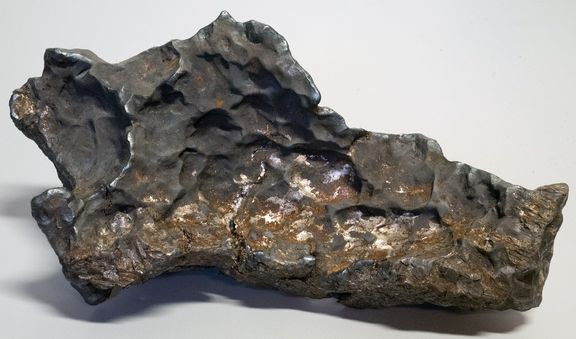Rare iron meteorite could help reveal secrets of early solar system
The sample is the first iron meteorite from a parent body with a known orbit.

Scientists have studied a rare iron meteorite in detail, discovering what orbit its parent body occupied before crashing into Earth. It is the first iron meteorite for which such orbit has been calculated.
The 12-inch-long (30 centimeters), 30-pound (14 kilograms) chunk of space rock fell to Earth after a fireball erupted over Sweden in 2020. Iron meteorites such as this constitute just around 2% of the space rocks that make it to Earth's surface, so the object became a rare and valuable sample for researchers.
Iron meteorites are believed to be fragments of molten metallic cores at the heart of planetesimals, small bodies that existed around 4.5 billion years ago. Many of these bodies eventually came together back then to form the solar system's planets, including Earth.
As such, the studies of meteorites like this can reveal valuable information about the state of the solar system in its infancy and the sorts of elements that ended up becoming incorporated into the planets, study team members said.
Related: Meteorite that crashed to Earth 3,500 years ago carved into arrowhead by Bronze Age hunters
“An excellent opportunity for research occurred when a bright fireball, mainly observed by the Finnish Fireball Network, on November 7, 2020, over Sweden, produced the first iron meteorite with a possibility to derive its pre-atmospheric trajectory," Jaakko Visuri, an analyst with the Finnish Fireball Network and Ursa Astronomical Association, said in a statement. "This provided us a unique chance to study the delivery mechanism of iron meteorites and to look for iron-rich reservoirs in the solar system."
Seizing this opportunity was a team of astronomers from Ukraine, led by Irina Belskaya, the head of the Department of Physics of Asteroids and Comets at Kharkiv National University's Institute of Astronomy. The research was conducted as part of a project started in 2020 dedicated to studying metal-rich asteroids, which are the parent bodies of iron meteorites.
"For the very first time, this discovery presents a documented trajectory of an iron meteoroid, showcasing a record-breaking fireball descent at a mere 7 miles (11.4 kilometers) above the Earth's surface and also unraveling the celestial pathways it traversed before gracing our planet," said Finnish Geospatial Research Institute researcher Maraia Gritsevich. (Meteoroids are small space rocks; they become meteors when they hit Earth's atmosphere and burn up. Pieces of these rocks that make it to Earth's surface are called meteorites.)
Get the Space.com Newsletter
Breaking space news, the latest updates on rocket launches, skywatching events and more!
"This achievement not only provides insights into the remarkable journey it endured but also contributes to our understanding of the origins and dynamics of iron-rich space objects, thereby deepening our insight into the broader solar system," Gritsevich added.
Among the information the scientists collected about the meteorite were clues about the conditions and processes that led to its formation. This could help determine how chemical resources are distributed through the solar system.
Such work could, in turn, potentially help prepare future space missions that hunt for metal-rich asteroids that could be enticing space-mining targets.
Calculating the orbit of the meteorite's parent body helps paint a picture of the celestial mechanics at play in the early solar system, including interactions between other bodies in our cosmic backyard and the gravitational forces at play.
In addition, better predicting the path of this object could help constrain the orbits of other asteroids, with implications for planetary defense, study team members said. As such, this small iron-rich rock from space could become a stepping stone for a wealth of future space science.
Join our Space Forums to keep talking space on the latest missions, night sky and more! And if you have a news tip, correction or comment, let us know at: community@space.com.

Robert Lea is a science journalist in the U.K. whose articles have been published in Physics World, New Scientist, Astronomy Magazine, All About Space, Newsweek and ZME Science. He also writes about science communication for Elsevier and the European Journal of Physics. Rob holds a bachelor of science degree in physics and astronomy from the U.K.’s Open University. Follow him on Twitter @sciencef1rst.
-
rod It would be good to see in meteorite reports, the radiometric age(s) found. Some show a spread of ages using different isotopes and what the CRE age(s) are too (cosmic ray exposure ages). Perhaps in the future, there will be a system of record (central repository) that discloses such age measurements to the public.Reply -
Torbjorn Larsson It is a follow up find on the meteorite that fell not far from where I live: https://www.livescience.com/iron-meteorite-recovered-sweden.html .Reply









